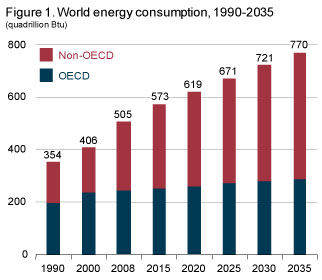So much for conservation. Global energy use set to explode

A new report from the U.S. Energy Information Administration predicts that global energy growth will increase by 53 percent between now and 2035, largely because of demand from countries outside the Organization for Economic Cooperation and Development (OECD).
The International Energy Outlook 2011 ties most of the growth to the fact that it believes established economies will grow more slowly after the current recovery than after past recoveries. If you look at the figure below, you'll see that the break-even year for energy usage by both groups of nations looks to be around 2008. By 2015, non-OECD nations will be using noticeably more energy than the OECD group, the report indicates.
The report anticipates that global electricity generation will grow by 84 percent during the timeframe considered: from 19.1 trillion kilowatt-hours in 2008 to 25.5 trillion kilowatt-hours in 2020 and 35.2 trillion kilowatt-hours in 2035.
As you might expect, the fastest growing generation technologies are from the renewable energy sector. The report figures that more than 82 percent of the increase in renewable generation will be from hydroelectric power and wind power.
The organization notes:
"High construction costs can make the total cost to build and operate renewable generators higher than those for conventional plants. The intermittence of wind and solar, in particular, can further hinder the economic competitiveness of those resources, as they are not operator-controlled and are not necessarily available when they would be of greatest value to the system. However, improving battery storage technology and dispersing wind and solar generating facilities over wide geographic areas could mitigate many of the problems associated with intermittency over the projection period."
The forecast is another reminder that it is not enough for the United States to focus simply on energy-efficiency technologies and projects, which will help keep a lid on our nation's own consumption. If the nation hopes to grab a piece of the growing demand for electricity outside our borders, it needs to keep investing in renewable technologies.
